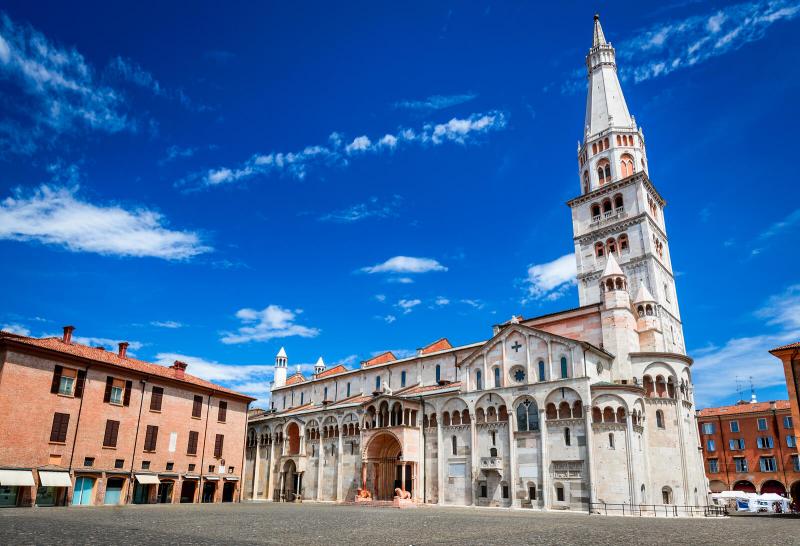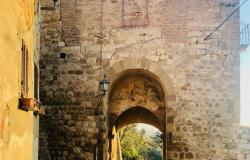The Heart of Modena: Piazza Grande, a Unesco World Heritage Site
ITA:

Use player to listen to Italian version
“The magnificent 12th-century cathedral at Modena, the work of two great artists (Lanfranco and Wiligelmus), is a supreme example of early Romanesque art. With its piazza and soaring tower, it testifies to the faith of its builders and the power of the Canossa dynasty who commissioned it.”
Thus Unesco describes the complex of Modena’s Cathedral, Torre Civica and Piazza Grande, a World Heritage Site since 1997.
Piazza Grande is Modena’s heart, around which the public life of this Emilian city has revolved for centuries. It is not ‘large’ as the name seems to imply, especially when compared to other Italian piazzas, but rather gathered around the magnificent Duomo and Ghirlandina Tower.
The Duomo is a masterpiece of Romanesque architecture and Modena’s most important historic building. Construction began in 1099, replacing an early Christian basilica, and ended in 1319, when the Ghirlandina bell tower was completed.
The Duomo is the work of architect Lanfranco and sculptor Wiligelmo, whose exceptional sculptural cycle from the beginning of the 12th century embellishes the façade and monumental doors.
Inside, it has a monumental feel, enhanced by the light that filters through the polychrome windows by Giovanni da Modena.
The funeral of the late famed tenor Luciano Pavarotti, a native of Modena, was held in the cathedral.
The Ghirlandina Tower is annexed to the Duomo. 86-meter tall, it is the symbol of Modena, visible from all directions outside the city. To compete with Bologna's towers, which were numerous in the Middle Ages, the city added the characteristic octagonal cusp. The top of the tower is decorated with two ghirlande (marble railings resembling wreaths), hence the name.
Approximately 200 steps take you up to the Stanza dei Torresani, the fifth floor of the tower, from where you can admire a splendid, 360° view over Modena.
“La magnifica cattedrale del 12° secolo di Modena, opera di due grandi artisti (Lanfranco e Wiligelmo), è un sommo esempio di arte romanica antica. Con la sua piazza e la torre svettante, testimonia la fede dei suoi costruttori e il potere della dinastia dei Canossa che la commissionarono”.
Così l'Unesco descrive il complesso della Cattedrale di Modena, Torre Civica e Piazza Grande, patrimonio dell'umanità dal 1997.
Piazza Grande è il cuore di Modena, attorno al quale la vita pubblica di questa città emiliana ruota da secoli. Non è ‘grande’ come pare suggerire il nome, soprattutto se paragonata ad altre piazze italiane, ma piuttosto raccolta attorno ai magnifici monumenti del Duomo e della Torre della Ghirlandina.
Il Duomo è un capolavoro di architettura romanica e il più importante edificio storico di Modena. La costruzione iniziò nel 1099, andando a sostituire una basilica paleocristiana, e terminò nel 1319, quando fu completata la torre campanaria.
Il Duomo è opera dell'architetto Lanfranco e dello scultore Wiligelmo, il cui eccezionale ciclo scultoreo dell'inizio del XII° secolo impreziosisce la facciata e le porte monumentali.
All'interno, ha un aspetto monumentale, esaltato dalla luce che filtra attraverso le vetrate policrome di Giovanni da Modena.
Il funerale del famoso tenore Luciano Pavarotti, nativo di Modena, si tenne nel Duomo.
La Ghirlandina è annessa al Duomo. Alta 86 metri, è il simbolo di Modena, visibile da ogni direzione fuori dalla città. Per competere con le torri bolognesi, che erano numerose nel Medioevo, la città aggiunse la caratteristica cuspide ottagonale. La cima della torre è decorata con due balaustre in marmo che sembrano ghirlande, da cui pare derivi il nome.
Circa 200 gradini portano alla Stanza dei Torresani, al quinto piano della torre, da dove si può ammirare uno splendido panorama a 360° su Modena.











